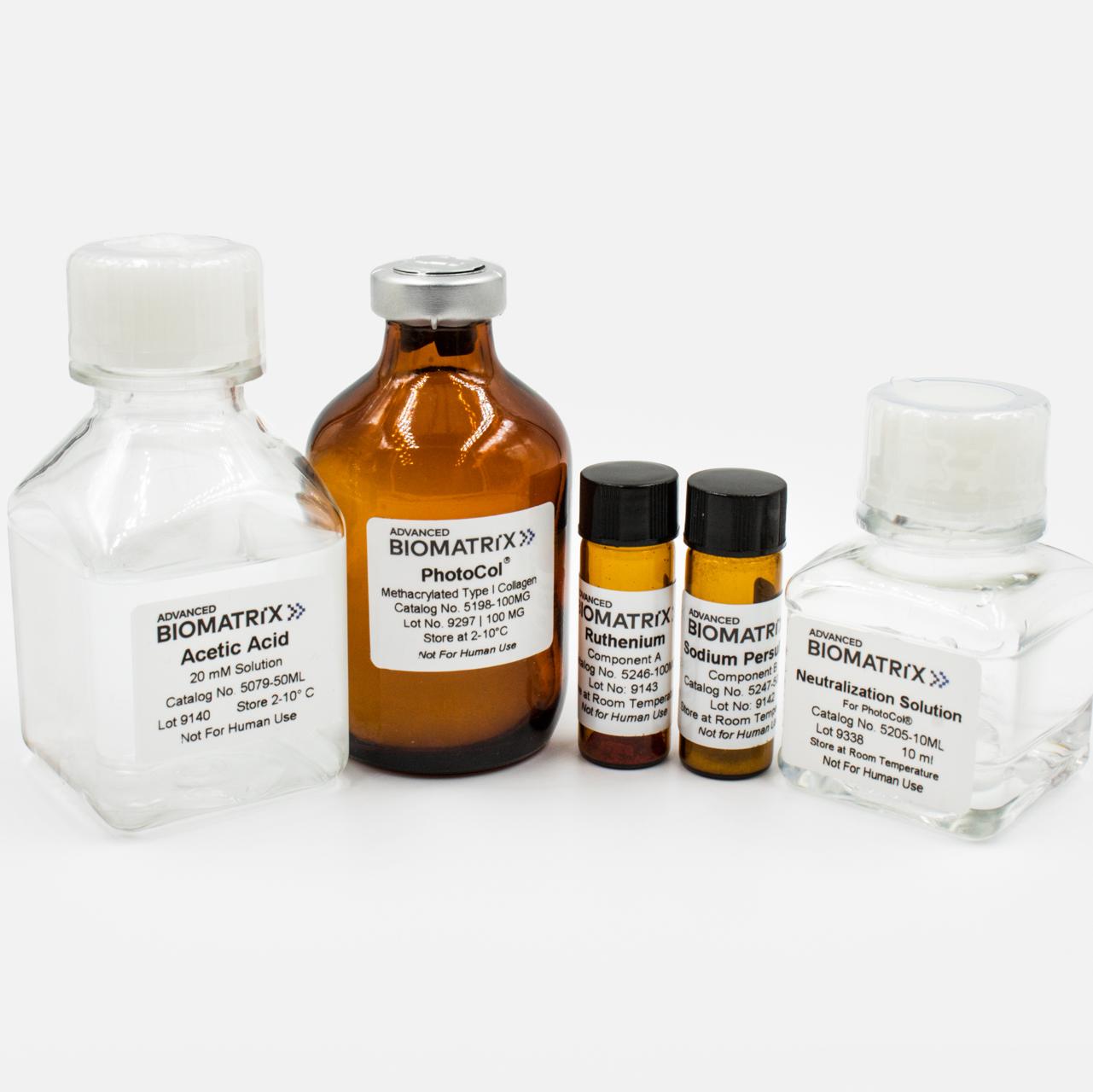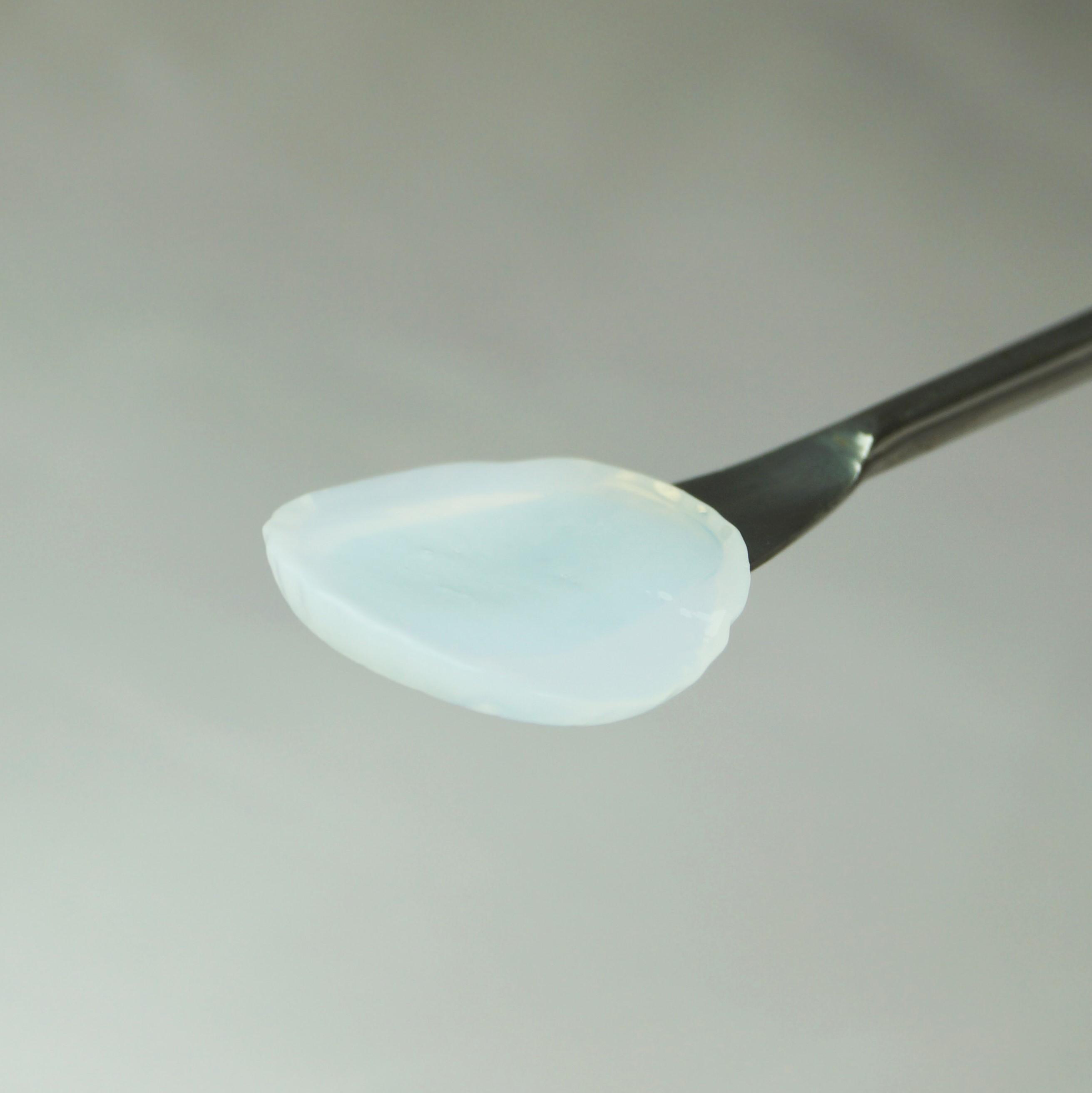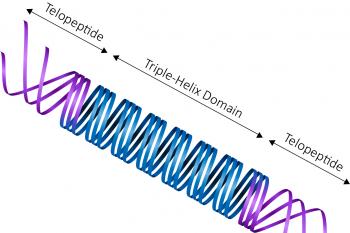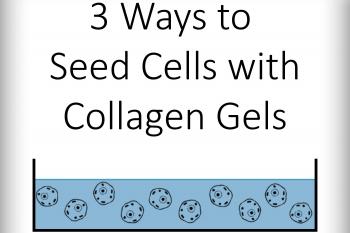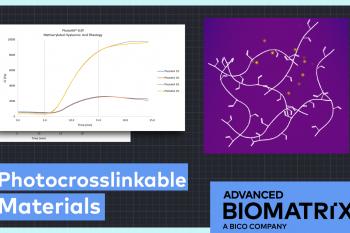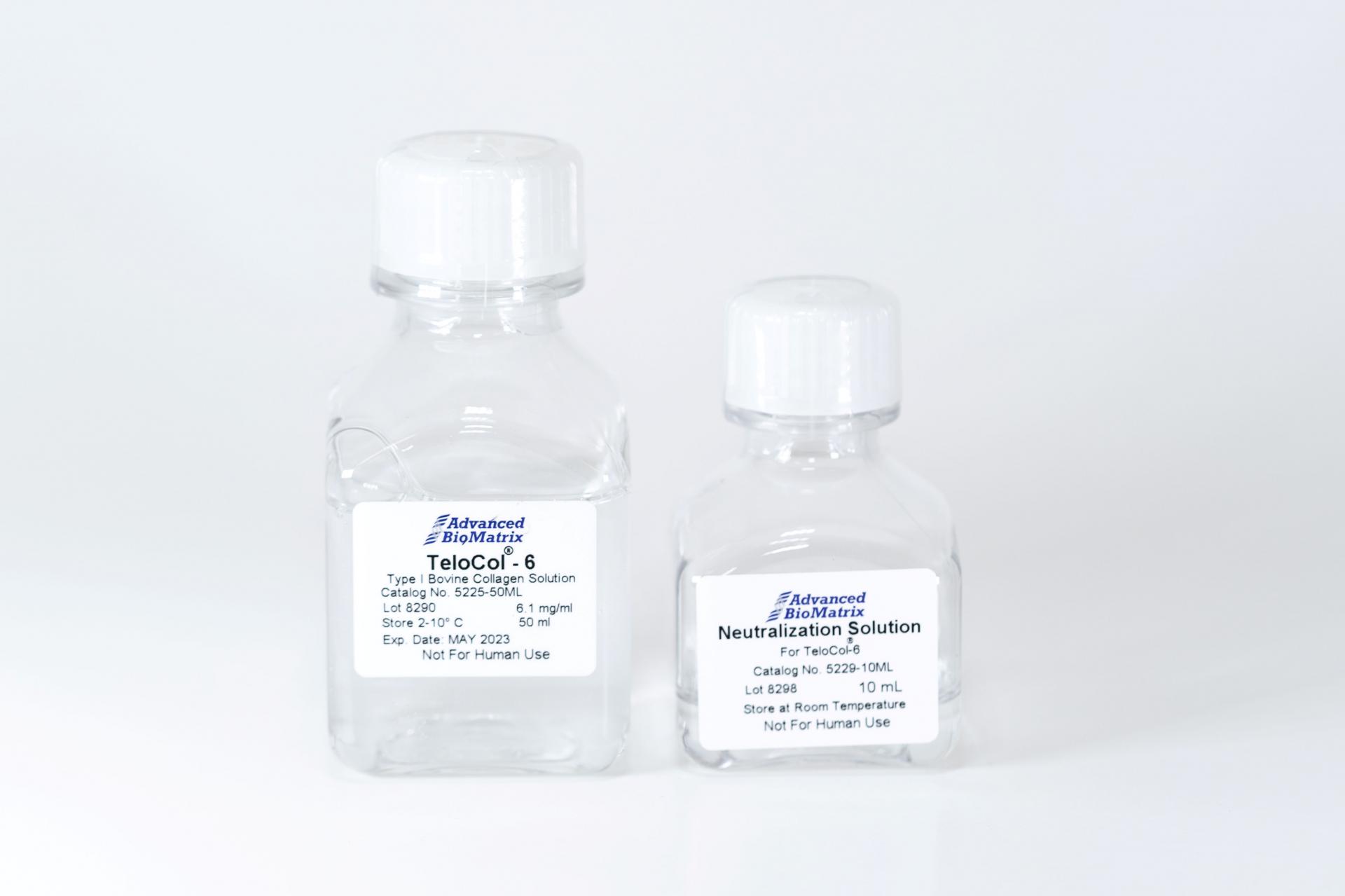-
Collagen
-
Type I - Atelocollagen
- PureCol® Solution, 3 mg/ml (bovine) #5005
- Nutragen® Solution, 6 mg/ml (bovine) #5010
- FibriCol® Solution, 10 mg/ml (bovine) #5133
- PureCol® EZ Gel, Solution, 5 mg/ml (bovine) #5074
- PureCol® Lyophilized, 15 mg (bovine) #5006
- VitroCol® Solution, 3 mg/ml (human) #5007
- VitroCol® Lyophilized, 15 mg (human) #5008
-
Type I - Telocollagen
- TeloCol®-3 Solution, 3 mg/ml (bovine) #5026
- TeloCol®-6 Solution, 6 mg/ml (bovine) #5225
- TeloCol®-10 Solution, 10 mg/ml (bovine) #5226
- RatCol™ for 2D and 3D, Solution, 4 mg/ml (rat) #5153
- RatCol™ High Concentration, Solution, 10 mg/ml (rat)
- RatCol™ lyophilized, 100 mg (rat)
- RatCol™ for Coatings, Solution, 4 mg/ml (rat) #5056
- Type I - Insoluble Collagen
- Type I - Bioinks
- Type II Collagen
- Type III Collagen
- Type IV Collagen
- Collagen Standard
-
PureCol® Collagen Coated Plates
- Collagen Coated T-25 Flasks #5029
- Collagen Coated 6-well Plates #5073
- Collagen Coated 12-well Plates #5439
- Collagen Coated 24-well Plates #5440
- Collagen Coated 48-well Plates #5181
- Collagen Coated 96-well Plates #5072
- Collagen Coated 384-well Plates #5380-5EA
- Collagen Coated 100 x 20 mm Dishes #5028
- MatTek Glass-Bottom Dishes
- MatTek Multi-Well Plates
- Collagen Scaffolds
- Collagen Hybridizing Peptides
-
Type I - Atelocollagen
- Tunable Stiffness
- CytoSoft™ Rigidity Plates
-
Bioprinting
- Support Slurry for FRESH Bioprinting
-
Bioinks for Extrusion Bioprinting
- Lifeink® 200 Collagen Bioink (35 mg/ml) #5278
- Lifeink® 220 Collagen Bioink (70 mg/ml) #5343
- Lifeink® 240 Acidic Collagen Bioink (35 mg/ml) #5267
- Lifeink® 260 Acidic Collagen Bioink (70 mg/ml) #5358
- GelMA Bioink
- GelMA A Bioink
- GelMA C Bioink
- Pluronic F-127 40% Sterile Solution
- GelMA 20% Sterile Solution
- Alginate 5% Sterile Solution
- Photoinitiators
- Bioinks for BIONOVA X
- Bioinks for Lumen X
- DLP Printing Consumables
-
Create Your Own Bioinks
- PhotoCol® Methacrylated Collagen
- PhotoGel® Methacrylated Gelatin 95% DS
- PhotoGel® Methacrylated Gelatin 50% DS
- PhotoHA®-Stiff Methacrylated Hyaluronic Acid
- PhotoHA®-Soft Methacrylated Hyaluronic Acid
- PhotoAlginate® Methacrylated Alginate
- PhotoDextran® Methacrylated Dextran
- PEGDA (Various Molecular Weights)
- Silk Fibroin, Solution
- PhotoSericin® Methacrylated Sericin
- Bioprinters
-
3D Hydrogels
- Thermoreversible Hydrogel
- Silk Fibroin
-
Type I Collagen for 3D Hydrogels
- PureCol® Solution, 3 mg/ml (bovine) #5005
- Nutragen® Solution, 6 mg/ml (bovine) #5010
- FibriCol® Solution, 10 mg/ml (bovine) #5133
- PureCol® EZ Gel, Solution, 5 mg/ml (bovine) #5074
- VitroCol® Solution, 3 mg/ml (human) #5007
- TeloCol®-3 Solution, 3 mg/ml (bovine) #5026
- TeloCol®-6 Solution, 6 mg/ml (bovine) #5225
- TeloCol®-10 Solution, 10 mg/ml (bovine) #5226
- RatCol® for 3D gels, Solution, 4 mg/ml (rat) #5153
- HyStem® Thiolated Hyaluronic Acid
- Methacrylated Collagen
- Methacrylated Gelatin
- Methacrylated Hyaluronic Acid
- Diacrylates
- Collagen Sponges
- Methacrylated Polysaccharides
- Spheroids and Organoids
- Extracellular Matrices
- HyStem / Hyaluronic Acid
-
Adhesion Peptides / Proteins
-
Recombinant Adhesion Proteins
- CD2, 0.5 mg/ml #5086
- CDH3, 0.5 mg/ml #5124
- CDH13, 0.5 mg/ml #5125
- CD14, 0.5 mg/ml #5089
- CDH18, 0.5 mg/ml #5090
- CD40, 0.5 mg/ml #5093
- CD86, 0.5 mg/ml #5096
- CD164, 0.5 mg/ml #5100
- CD270, 0.5 mg/ml #5127
- CD274, 0.5 mg/ml #5126
- CD276, 0.5 mg/ml #5123
- E-Cadherin (CD324), 0.5 mg/ml #5085
- ICAM2, 0.5 mg/ml #5107
- Adhesion Peptides
- Collagen Hybridizing Peptides
-
Recombinant Adhesion Proteins
- Reagents
- Assays
PhotoCol®
Methacrylated Collagen
Catalog #5198, #5201, #5270, #5271



PhotoCol®
Methacrylated Collagen
Catalog #5198, #5201, #5270, #5271
PhotoCol® is 100 mg of lyophilized methacrylated Type I collagen. PhotoCol® provides native-like 3D collagen gels with the unique attributes to be prepared at various concentrations and photocrosslinked (requires a photoinitiator) to provide various gel stiffness.
Product Description
Advanced BioMatrix offers PhotoCol®, a purified methacrylated Type I bovine collagen kit. PhotoCol® provides native-like 3D collagen gels with the unique attributes to be prepared at various concentrations and crosslinked to provide various gel stiffness.
PhotoCol® kits consists of purified methacrylated Type I bovine collagen as the core component with other support reagents in the kit. This PhotoCol® product only contains the methacrylated collagen. For the entire photocrosslinking kit, please purchase one of the "Kits." The kits each contain the first three rows shown below, accompanied by the selected photoinitiator.
Table 1:
| Item | Catalog Number | Package Size | Storage Temperature |
| Methacrylated Collagen | #5198 | 100 mg | 2-10°C |
| 20 mM Acetic Acid | #5079 | 50 mL | 2-30°C |
| Neutralization Solution | #5205 | 10 mL | Room Temperature |
The methacrylated Type I collagen is produced from telo-peptide intact bovine collagen where the collagen has been modified by reacting the free amines, primarily the ε-amines groups of the lysine residues as well as the a-amines groups on the N-termini. > 20% of the total lysine residues of the collagen molecule have been methacrylated. The collagen is extracted from bovine hide and contains a high monomer content.
| Parameter, Testing, and Method | Methacrylated Collagen #5198 |
| Sterilization Method | Filtration |
| Extraction Method | Acid - Telocollagen |
| Form | Lyophilized Powder |
| Degree of Methacrylation | >20% |
| Package Size | 100 mg |
| Storage Temperature | 2-10°C |
| Shelf Life | Minimum of 6 months from date of receipt |
| Shelf Life After Reconstitution | 2 months |
|
Collagen Purity - Silver Staining |
>99% |
| Kinetic Gel Test (Minutes) | <40 |
| Gel Formation Tube Test (Minutes) | <40 |
|
Electrophoretic Pattern - Coomassie Blue |
Characteristic |
| Sterility - USP modified | No growth |
| Endotoxin (LAL) | <10.0 EU/mL |
| Source | Bovine Hide |
| Hydrogel Young's Modulus E (Pa) | Characteristic |
Directions for Use
Download the full Directions for Use PDF
Download the full Directions for Use PDF (IRGACURE)
Download the full Directions for Use PDF (LAP)
Download the full Directions for Use PDF (RUTHENIUM)
NOTE: For LAP photoinitiator, the basic recommendations will result in a ~0.03% final LAP concentration. For some applications, such as DLP printing, the final LAP concentration should be increased to ~0.25-0.5% to accelerate and improve crosslinking.
Product Applications
Read our Methacrylated Extracellular Matrices eBrochure Here
PhotoCol® Methacrylated Collagen is a photocrosslinkable type I collagen for 3D cell culture and bioprinting.
As the most abundant protein in the body, collagen is a key component for cell culture. Collagen methacrylate can be used as a rapidly self-assembling type I collagen to form cross-linked hydrogels for tissue engineering[1]. It has been used with mesenchymal stem cells[2], fibroblasts, adipose derived stem cells, epithelial cells, and many more.
Collagen methacrylate is useful for forming scaffolds with varying degree of stiffness, by altering collagen concentration or the dose of UV-light exposure[2]. It is also being extensively characterized for its usefulness in 3D bioprinting (extrusion, inkjet, and photolithographic[3]).
PhotoCol® has been used for created 3D microniches[4], as well as for 3D bioprinting human corneas[5].
References:
Product References
References for PhotoCol®:
Zhang, Q. et al. Implantation of a nerve protector embedded with human GMSC-derived Schwann-like cells accelerates regeneration of crush-injured rat sciatic nerves. Stem Cell Research & Therapy 13, (2022).
Pamonag, M. et al. Individual cells generate their own self-reinforcing contact guidance cues through local matrix fiber remodeling. PLOS ONE 17, (2022).
Maloney, E. et al. Immersion Bioprinting of Tumor Organoids in Multi-Well Plates for Increasing Chemotherapy Screening Throughput. Micromachines 11, 208 (2020).
Isaacson, A., Swioklo, S. & Connon, C. J. 3D bioprinting of a corneal stroma equivalent. Experimental Eye Research 173, 188–193 (2018).
Kathryn E. Drzewiecki et al, A thermoreversible, photocrosslinkable collagen bio-ink for free-form fabrication of scaffolds for regenerative medicine, TECHNOLOGY (2017).
Drzewiecki, K. E. et al. Methacrylation Induces Rapid, Temperature-Dependent, Reversible Self-Assembly of Type-I Collagen. Langmuir 30, 11204–11211 (2014).
Gaudet, I. D. & Shreiber, D. I. Characterization of Methacrylated Type-I Collagen as a Dynamic, Photoactive Hydrogel. Biointerphases 7, 25 (2012).
Izadifar, Mohammad, et al. "UV-assisted 3D bioprinting of nanoreinforced hybrid cardiac patch for myocardial tissue engineering." Tissue Engineering Part C: Methods 24.2 (2018): 74-88.
Stoecklin, Celine, et al. "A New Approach to Design Artificial 3D Microniches with Combined Chemical, Topographical, and Rheological Cues." Advanced Biosystems (2018): 1700237.
Mazzocchi, Andrea, et al. "Optimization of collagen type I-hyaluronan hybrid bioink for 3D bioprinted liver microenvironments." Biofabrication (2018).
Nguyen, T. U., Watkins, K. E. & Kishore, V. Photochemically crosslinked cell‐laden methacrylated collagen hydrogels with high cell viability and functionality. Journal of Biomedical Materials Research Part A107,1541–1550 (2019).
Mazzocchi, A. et al.Pleural Effusion Aspirate for Use in 3D Lung Cancer Modeling and Chemotherapy Screening. ACS Biomaterials Science & Engineering5,1937–1943 (2019).
Chhetri, A. et al. Cell Culture and Coculture for Oncological Research in Appropriate Microenvironments. Current Protocols in Chemical Biology11,(2019).
Product Certificate of Analysis
No result for .
Product Videos
Safety and Documentation
Product Disclaimer
This product is for R&D use only and is not intended for human or other uses. Please consult the Material Safety Data Sheet for information regarding hazards and safe handling practices.
